Val Forbes brought me a new binding, a gift for me when she came to my open studio, and I'd like to share it with you. She saw it at a crafts fair in Australia, then found it in the book Live & Learn: Real Life Journals: Designing & Using Handmade Books by Gwen Diehn under the name Flat-Style Australian Reverse Piano Hinge binding (which is just one syllable short of supercalifragilisticexpialidocious). It is true that it employs the mechanism of a piano hinge. It is true that the hinge is inside, and therefore reversed. And yes, it lies nice and flat. Once other people know what it is, I am hoping we can call it Australian Piano Hinge, or at least use that as a friendly nickname. But never mind the name. Let's make the book.
Tools: pencil; metal ruler; art knife and cutting mat; bone folder; PVA and scrap of board for gluing
Materials: lightweight to medium weight paper for accordion (colored charcoal paper is good), 9" x 3" (23 cm x 7.5 cm), grained short; Six pieces of medium weight paper or three pieces of heavyweight paper, 9" x 5" (23 cm x 13 cm), grained short for the signatures; One piece of heavyweight paper or card (to cut into three strips), 3" x 5" [7.62 cm x 12.7 cm] trimmed to three 1" x 5" [2.54 cm x 12.7 cm] strips
For the signatures, I'm using heavyweight paper that I painted on one side (nicer if painted on both!), and a piece of yellow Canson Mi-Tientes for the accordion. See Painted Paper: Techniques & Projects for Handmade Books & Cards for painting techniques with acrylic inks.
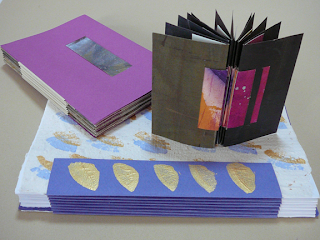 |
| Top: two of my models Bottom: model by Val Forbes |
Materials: lightweight to medium weight paper for accordion (colored charcoal paper is good), 9" x 3" (23 cm x 7.5 cm), grained short; Six pieces of medium weight paper or three pieces of heavyweight paper, 9" x 5" (23 cm x 13 cm), grained short for the signatures; One piece of heavyweight paper or card (to cut into three strips), 3" x 5" [7.62 cm x 12.7 cm] trimmed to three 1" x 5" [2.54 cm x 12.7 cm] strips
For the signatures, I'm using heavyweight paper that I painted on one side (nicer if painted on both!), and a piece of yellow Canson Mi-Tientes for the accordion. See Painted Paper: Techniques & Projects for Handmade Books & Cards for painting techniques with acrylic inks.
Start by folding the accordion into eight panels.
Fold long strip in half, widthwise.
Fold ends in to center fold.
Fold ends back out to new folds.
Flip over.
Bring folded edges to center and press down.
Open to accordion, ends pointing up like a W.
Fold your pages in half. If they are lighter weight,
and you are using six,
you can nest them into signatures.
After they are in signatures
you may wish to trim them evenly.
Open one signature and center the accordion
on the inner fold.
Using the accordion as a guide,
mark on the fold of the signature at each end.
With the knife against the metal ruler,
cut a slit from mark to mark
on that inner fold.
Repeat for all signatures.
Tip: Use the first signature for a template.
and instead of marking every signature,
use a pushpin or awl to make a hole at each end,
then cut the slits by connecting the holes.
Once the slits are cut, you can slide the first
mountain fold into one of the slits.
(please excuse blur of excitement)
Continue with the remaining mountain folds and signatures.
Now take the piece of card and cut strips that will fit
inside the mountain folds that show inside.
In this case, my strips were 1" each (2.54 cm)
Slide one strip into the tube made by the mountain fold.
Continue with all strips and mountain folds.
Use a piece of scrap board and apply PVA
to one end of the accordion
that shows on the outside of the book.
Press down and wipe away any glue immediately.
Repeat the previous steps for the other end.
Press down with a bone folder to firm up the folds.
This model has three signatures.
For a thicker book, use an accordion that is
twice the length.
Fold in half, then fold each half into eight panels
as shown, above, and use six signatures.
Variations
- Use six signatures with 6-18 pages, total.
- Attach a different style cover, such as open spine (p. 206, Making Handmade Books: 100+ Bindings, Structures & Forms or other covers, pages 203-220).
- Sew the outer accordion flaps instead of gluing them down.
- Cut slits in the front and back cover and weave the ends of the accordion into the covers.
- Make a flag book by using cards and putting the slits 1/4" [64 mm] from the left edges of the cards instead of through the center of signatures.
- Make several books and create a handmade box for them!
Warm Wishes for the New Year!
Thank You for reading!
Dimension corrections to materials list: 7/18/16
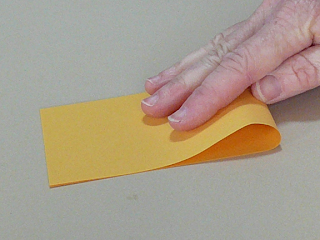
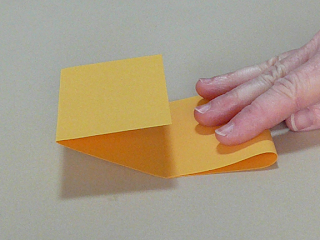
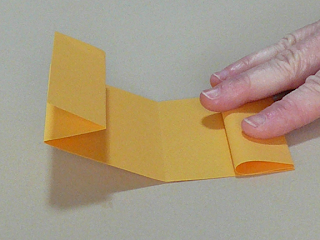
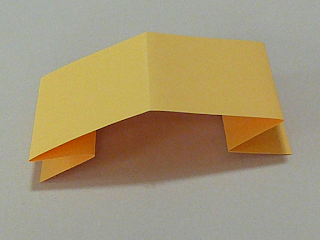
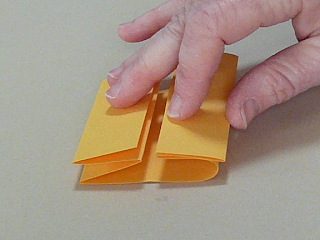
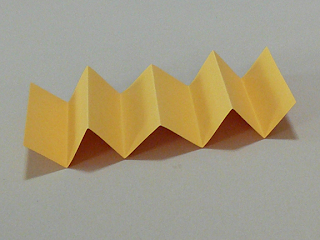
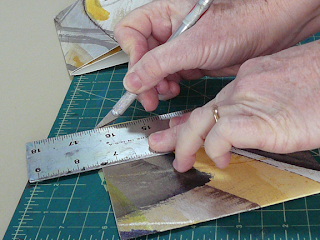
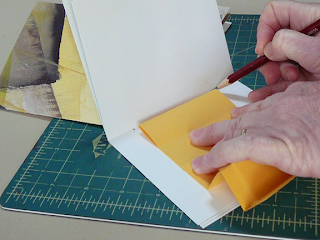
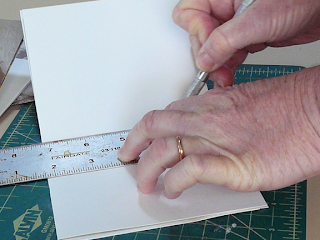
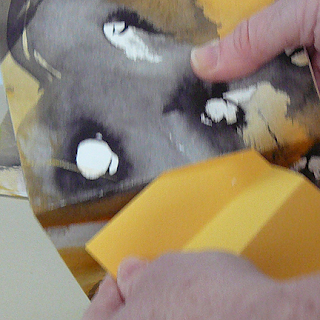
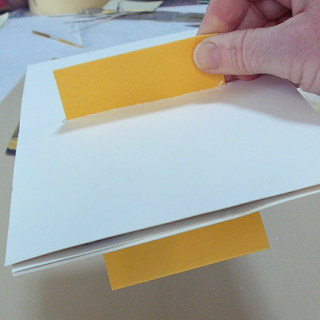
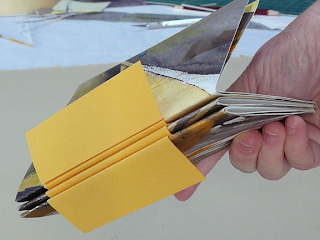
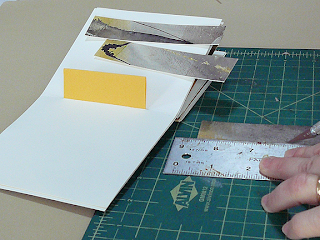

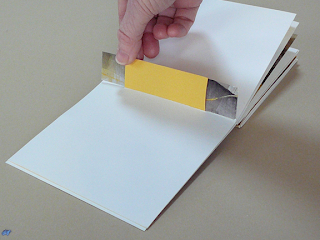
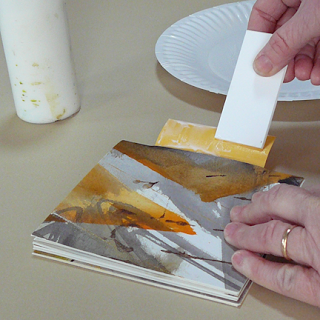
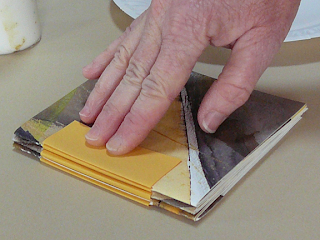
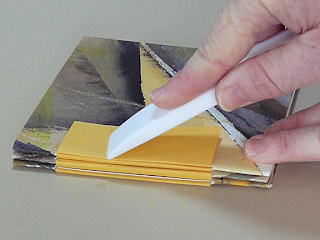
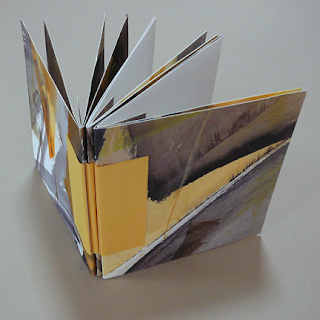
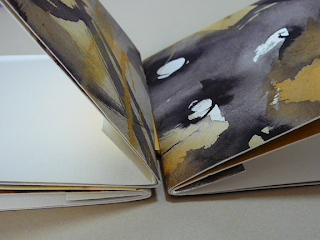
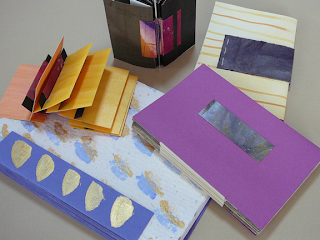
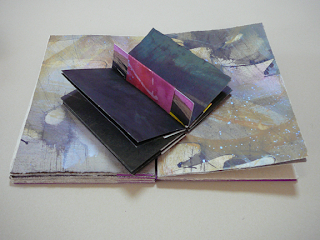
Comments
Best to you as 2012 nears its close!
Patricia from Canada
Given the local propensity for abbreviating everything, I expect it will be known as Aussie(or Oz) Hinge!
Happy Christmas, Alisa.
I think there are a million possibilities for this, including cutting windows in the mountain folds that would reveal pictures or words on the cards.
And I wonder how it would work with cloth, with perhaps a stiffener fused to strips for the "cards?"
Whatever you find for the Oz book, we look forward to hearing about it!
I was thrilled that you liked my gift so much that it made it onto your blog! You mentioned cutting windows into the mountain folds. I achieved this by using a small craft punch to cut out ginkgo leaf shapes in the mountain folds which were highlighted by the contrasting paper strips inside, then used the cut out shapes to decorate the cover. I'm sure people will come up with lots of ingenious ways to use this super structure. Wishing you and your readers a happy holiday season!
Val
One piece of heavyweight paper or card (to cut into three strips), minimum size 3" x 5" [8 cm x 13 cm], grained long. (Note: 5" x 5" [13 cm x 13 cm] will be easier to trim to 1" x 5" [2.54 cm x 13 cm] strips).
Thanks for that! I've revised the materials list to reflect your corrections. I think I meant the minimum size could be 3" high because that is how high the "tubes" are. But 5" strips hold much better. It was confusing as it stood, so I've cleaned that up, too. Thanks for pointing it out!
-Alisa